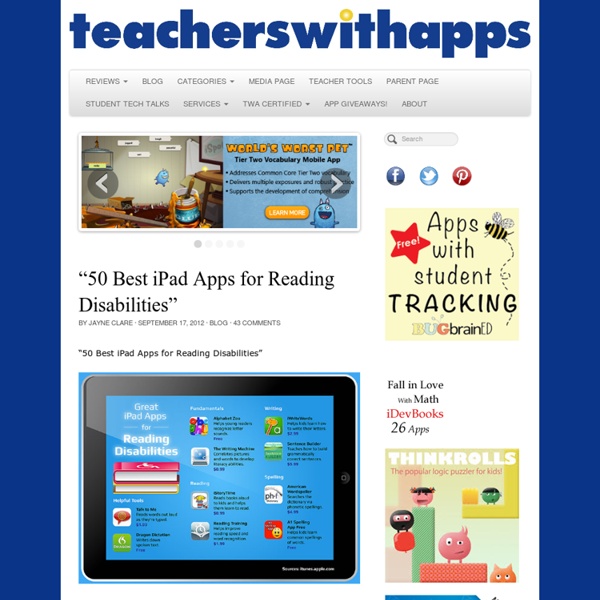“50 Best iPad Apps for Reading Disabilities”
“50 Best iPad Apps for Reading Disabilities” Guest Blog by Rosa Ray Whether you’re the parent of a child with a reading disability or an educator that works with learning disabled students on a daily basis, you’re undoubtedly always looking for new tools to help these bright young kids meet their potential and work through their disability. While there are numerous technologies out there that can help, perhaps one of the richest is the iPad, which offers dozens of applications designed to meet the needs of learning disabled kids and beginning readers alike. Helpful Tools These tools are useful for both educators and students with reading disabilities alike, aiding in everything from looking up a correct spelling to reading text out loud. Speak It! Fundamentals These apps help teach the fundamentals of reading, writing, and spelling to any young learner, but can be especially helpful for those who are struggling. Reading Writing Spelling
Related: Accessibility
Speak it! Text to Speech
15 Great iPad Apps for Special Education Students
1- Autism Timer " Autism Timer is a digital timer that shows the elapsed time clearly and is easy to use. You can set three different time for green/yellow/red zone. 2- Behavior Assessment Pro " Behavior Assessment Pro is an iPhone, iTouch and iPad application that identifies factors related to problem behaviors. 3- My Talk Tools "MyTalkTools Mobile for the iPhone, iPod touch and iPad enables people with communication difficulties to express their needs and desires to those around them 4- Glow Draw " This is a great iPad app for drawing." 5- Talkulator " Talking calculator. 6- iConverse " iConverse is an educational tool designed for young children, autistic individuals, and individuals with other communicative disabilities, and also toddler-aged children who have yet to master language......" 7- My Choice Board " The primary purpose of MY CHOICE BOARD is to present a visual display of “choices” to those with limited communication skills. 8- My Homework 9- iCommunicate 10- Aurifi 11- AutismXpress
Blog | The Magic of Learning
Remote Scavenger Hunt We are heading into our third week of social distancing, school closures and “shelter at home&... We are in the Midst of... Are you aware that we are in the middle of making history? It is March of 2020. We are living throug... #remotelearning as an ...
Draw Free for iPad
Proloquo2Go
Symbol-supported communication app to promote language development and grow communication skills, from beginning to advanced communicators Unique feature combination Proloquo2Go is the only AAC app that combines unique features, such as research-based vocabulary levels, (activity) templates to support motor-planning, ExpressivePower™ to express yourself and full bilingual support. And all that with minimal customization effort! Proloquo2Go is designed to ensure growth of communication skills and to promote language development. It covers all users, from beginning to advanced users, while catering for a wide range of fine-motor, visual and cognitive skills. ‘AssistiveWare has done a beautiful job of listening to the AAC community's feedback, adding powerful features in Proloquo2Go 5 including Search with guided navigation and automatic backups.’ Who is Proloquo2Go for? We have tons of free support materials available.
IntoWords
Talking Calculator
5 iPhone Apps for Students With Disabilities
Photo Credit: smh.com.au You may not realize it, but people with disabilities are also at a disadvantage when it comes to education. Studies show that 54 million Americans have disabilities. 28% of those with disabilities aged 25 and above barely even finished high school. More than 16 million people in America have a mental illness or a cognitive function problem while 3 million people have difficulty with speech communication, thus hindering them from learning independently. However, learning can be facilitated, even for people with disabilities, through the help of mobile devices like the iPhone. If you’re a parent of a disabled child or a teacher for disabled students, you can make learning more interesting for them with the help of these apps! ArtikPix One of the best learning methods for children is the use of pictures and graphics, one thing that modern technology such as the iPhone can now offer for free. In My Dreams ADHD Angel TapToTalk Learn Braille Alphabet
Related:



